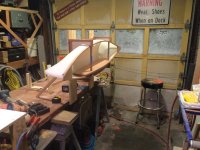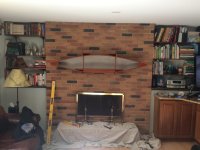The 1/8" thick Divinycell arrived yesterday. It was rolled for shipping, pretty dramatic unleashing! Here's a look at the left over chunk. BTW, it feels about as hard as cedar.
I laid the foam into the bottom of the shell, and penciled in a trim line a little ways above the bilge. I trimmed the foam with a utility knife, and marked the location of the foam in the shell with a red Sharpie so I reposition the foam in the same spot. And also so I could apply just enough epoxy.
The foam was a bit stiff. I played around with the heat gun to thermoform it, but that was taking a lifetime. I also filled many zip lock sandwich bags with water, to use as a conformal ballast. Every bag leaked, so that was out too. So, due to excess excitement and a shortage of forethought, I decided to wing it!
I mixed 12 oz of epoxy and added Cabosil to give it some body. I poured the thickened epoxy directly into the shell, and spread it out with a squeegee.
Here's a look at the partially spread out epoxy, you should be able to see my red traced line, and the poured in epoxy.
From there it was a simple matter to place the foam back in the shell, lining it up as it was before. And....wait for it....yup, I paid the price for my haste!
While the Divinycell laid in the shell nicely, it didn't fully conform to all of the contours. For the next 30 minutes, I was scrambling around, looking for every piece of compliant (and not so compliant) ballast that I could find. Window casing, baseboard, short 2 x 4's, paint cans, 6 ft level, bags of grout, bags of plaster, more paint cans, yup, I even have a bag of Weed n Feed in there...It wasn't pretty.
But, I think I have all of the foam intimately in contact with the shell.
Here's a look at my near disaster
Once the epoxy is firmed up, I'll add a layer of carbon and a layer of glass.
And that should stiffen the bottom adequately. The rest of the shell has enough curves and creases to provide plenty of stiffness. The stems are particularly rugged.
Side note for Jim: I'm expecting the 1/8" Divinycell will provide the same bump in stiffness as did your 1/8" cedar strips. Even more so, since I'm planning to add a layer of carbon as well as a layer of glass.
MDB has been bugging me for a few years to build something using foam instead of cedar. If I could imagine a simple way to make a complete 1/8" foam shell, I could wrap that in whatever and be done! Like I said in my hijack of your thread (sorry man) 22lbs/cu ft vs 5 lbs/cu ft ain't much of a contest!
I'll leave it to you and Allen to devise a way to spit out foam shells. Once you had a foam shell, you could laminate the same way as the average stripper, and have a sturdy, lightweight hull.
 , I'll be look for the fold out !
, I'll be look for the fold out ! 


